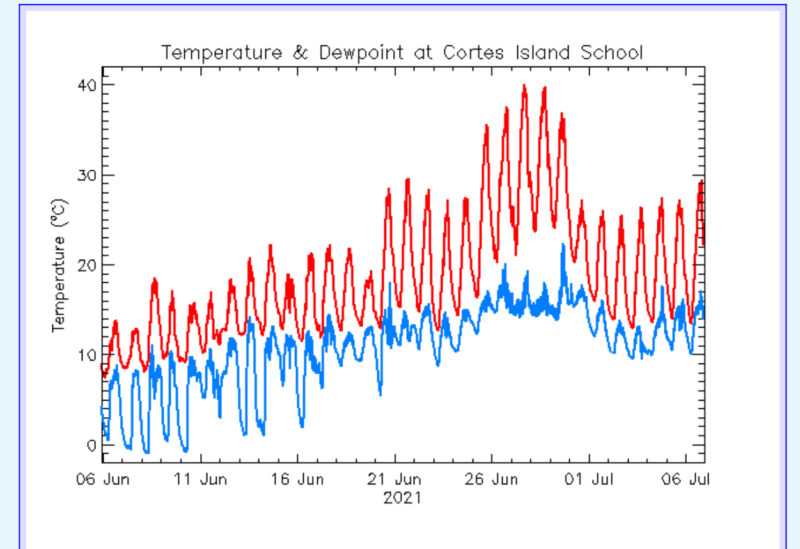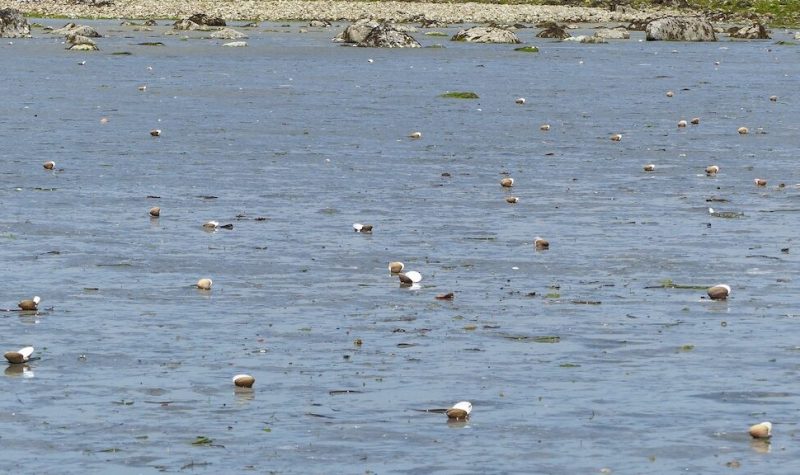By Roy L Hales
In the midst of a heat wave that may have left as many as a billion marine creatures dead along the West Coast, there has been a high number of shellfish deaths reported at a few of Cortes Island locations.
Daily temperature highs of between 35°C and 40°C were recorded at the Cortes Island School during the last five days of June.

The seven day tidal prediction for Twin Islands at the end of June during BC's heat wave. Photo courtesy of the Department of Fisheries and Oceans Canada.
Mike Manson reported a high number of dead cockles in front of Hollyhock, Cortes Island, on June 27.
“On a low tide of 2 feet or less, I would typically expect to find maybe half a dozen live ones partially exposed in the sand, and maybe a few more dead ones that sharp-eyed gulls had spotted and turned into a meal. To see several hundred half shells littered across the beach was a shock,” he wrote.
“I also noticed a die-off of red rock crabs, counting about 50 in a small area. 2-4 inch shell size, not moulting, these were intact carcasses with legs et al," Manson later emailed.
Cortes Island biologist Sabina Leader-Mense added that what Manson witnessed was typical in severe heat waves.
“The cockle die-off Mike Manson observed is classic, as cockles have the shortest siphons, sitting at shallow depths, where they are vulnerable to the heat," Leader-Mense said.
A Squirrel Cove resident, who did not wish to be identified, said there was a persistent stench coming from the beach beside his home, as long as the high temperatures persisted. He suggested there may have been a "partial die off" of the oysters.
Curt Cunningham, owner/manager of the Squirrel Cove General Store, and his sister, Lynne Cunningham, also noticed the unusual odour. They said some of the store’s customers complained about it.
A week after the return to normal temperatures, Michele Douglas, from the Friends of Cortes Island (FOCI), carried out a quick survey of the area.
“The first thing is, it actually smelled a bit of a different beach odour than I would normally have smelled. Sometimes low tide can smell a bit sulphury, but this just kind of smelled dead, one would say. It was definitely an unpleasant odour,” she said.
Douglas found "quite a few live oysters" and "quite a few that looked like they had died recently" between the boat launch and dock. She believed that the deaths were recent.
“[If] the shell was open a little bit, and you could pry it open, and there was also still some organic material in there. I also sniffed them, if it smelled pretty fresh, then I presumed it had died in the last week or so.”
Douglas counted 10-12 dead oysters. Never having carried out any previous examinations in Squirrel Cove, she did not have a base line to compare her findings with over time.
“It is hard to say if there are always dead oysters on the beach? Or maybe it is totally related to this heat wave?” she asked.

June 2021 temperatures at Cortes Island School during BC's recent heat wave. Graph courtesy of Mike Manson.



